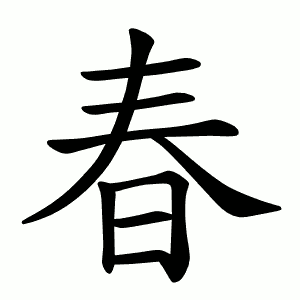春
- spring (season);
Etymology
Compound of imagery and phonetic elements:
日 (sun) – representing sunlight and warmth.
屯 (to station, sprout) – phonetic element, also linked to “sprouting” or beginning.
林 / 艸 (trees or grass) – representing vegetation, growth, renewal.
Together, the character depicts “the sun shining on sprouting plants,” symbolizing springtime and renewal of life.
Semantic range:
- the spring season, one of the four seasons;
- youth, vitality, prime of life;
- sexual desire, erotic overtones (especially in compounds);
- figurative: beginnings, renewal, flourishing.
Usage in Korean
春天 (춘천) – spring season
靑春 (청춘) – youth, the prime of life
思春期 (사춘기) – adolescence, puberty
買春 (매춘) – prostitution (lit. “buying spring”)
春色 (춘색) – spring scenery; also euphemism for sensuality
Additional notes
In classical literature, 屯 was sometimes used interchangeably with 春 as a phonetic loan.
Alternative forms
萅
Similar shape characters
This character is not to be confused with 舂 (U+8202) (to pound on grains in a mortar in order to husk them) which is visually similar but unrelated.
